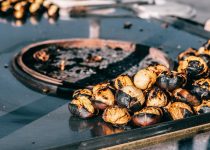How Long to Cook Boneless Butt Pork Roast on Rotisserie
You're gearing up to embark on a culinary adventure, and the star of the show is a boneless butt pork roast that's about to take a spin on the rotisserie.
As you prepare to fire up the grill and savor the tantalizing aroma of slowly roasting meat, you may find yourself wondering just how long it will take to achieve that perfect, juicy tenderness.
Fear not, because by the time you're done here, you'll have all the savory details on cooking time and temperature that will leave you eagerly anticipating the results.
Selecting the Right Pork Roast
When choosing a pork roast for rotisserie cooking, opt for a well-marbled cut with a good balance of fat for juiciness and flavor. Look for cuts like pork loin, pork shoulder, or pork tenderloin. These cuts are ideal for rotisserie cooking as they hold up well on the spit and retain their moisture and tenderness.
For rotisserie cooking, boneless pork roasts are the best choice as they cook more evenly and are easier to carve once done. Consider the size of the roast as well, ensuring it fits securely on the rotisserie spit without touching the heating elements.
When it comes to cooking methods, rotisserie cooking offers a unique way to prepare pork roast, allowing it to self-baste as it rotates, resulting in a crispy, flavorful exterior and a juicy interior. The constant rotation ensures even cooking and caramelization of the meat's surface.
Understanding the different pork roast cuts and the ideal cooking methods for rotisserie cooking will help you achieve a perfectly cooked, succulent pork roast every time.
Preparing the Rotisserie
Before you start cooking, it's crucial to ensure your rotisserie is assembled correctly and all safety precautions are in place. Check that all the parts are securely fastened, and that the motor is working smoothly.
Once everything is set up, make sure to properly secure the pork roast on the rotisserie spit to prevent any mishaps during the cooking process.
Rotisserie Assembly
To prepare the rotisserie for cooking the boneless pork roast, start by assembling the skewer and securing it tightly in place on the rotisserie motor. Ensure that the rotisserie is clean and well-maintained to avoid any issues during the cooking process.
Here are some key points to consider for rotisserie assembly:
- Check the skewer for any signs of wear and tear, and replace if necessary.
- Secure the meat onto the skewer, ensuring it's balanced for even cooking.
- Double-check the rotisserie motor for any loose parts or abnormalities before turning it on.
- Position the rotisserie in a safe and stable location, away from any flammable materials.
- Test the rotisserie's rotation to confirm it's working smoothly before placing the pork roast.
Following these steps will help ensure a successful rotisserie assembly for cooking your boneless pork roast.
Safety Precautions
As you prepare the rotisserie for cooking, it's crucial to prioritize safety precautions to ensure a smooth and secure cooking process.
Before starting, carefully inspect the rotisserie and its components for any signs of wear or damage. Make sure that the cooking equipment, including the rotisserie motor and spit, are securely assembled and in good working condition.
Position the rotisserie in a safe and stable location, away from any flammable materials or surfaces.
Additionally, always use a meat thermometer to ensure that the pork roast reaches the recommended internal temperature for safe consumption.
Securing the Pork
Now that you've ensured the rotisserie and its components are in good working condition, it's time to securely position the boneless pork roast on the spit and prepare it for the cooking process. Properly securing the pork ensures even cooking and a delicious outcome.
- Use a sturdy kitchen twine to tie the pork roast firmly to the rotisserie spit. This will prevent it from shifting or coming loose during the cooking process.
- Ensure the pork roast is centered on the spit to maintain rotisserie balance, allowing for even cooking and optimal flavor.
- Double-check the rotisserie's balance by gently rotating the spit by hand. Make adjustments if necessary to ensure it rotates smoothly without wobbling.
- Place a reliable temperature probe into the thickest part of the pork roast to monitor its internal temperature throughout the cooking process.
- Confirm that the rotisserie's temperature settings are calibrated correctly to achieve the desired level of doneness.
Seasoning the Pork Roast
You've got a few options when it comes to seasoning your pork roast for the rotisserie. Whether you prefer a dry rub or a marinade, the key is to infuse the meat with flavor and tenderness.
After choosing your seasoning, make sure to massage it into the roast thoroughly and let it marinate for a few hours for the best results.
Seasoning Options
Consider applying a generous amount of your favorite seasoning blend to the pork roast, ensuring a flavorful and aromatic result.
When seasoning your boneless butt pork roast for the rotisserie, here are some options to consider:
- Dry Rubs: Create a custom blend of herbs, spices, and seasonings for a personalized flavor profile.
- Herb Paste: Combine fresh herbs, garlic, and olive oil to form a fragrant paste for coating the roast.
- Citrus Marinade: Use a mixture of citrus juices, herbs, and a touch of sweetness to infuse the meat with bright and tangy flavors.
- BBQ Sauce Basting: Apply layers of your preferred barbecue sauce throughout the cooking process for a caramelized and smoky finish.
- Asian-Inspired Glaze: Experiment with soy sauce, ginger, and honey for a savory-sweet glaze that adds depth to the pork roast.
These seasoning options can elevate the taste of your boneless butt pork roast on the rotisserie, providing a delightful culinary experience.
Preparing the Roast
To infuse your boneless pork roast with flavor, start by generously applying your preferred seasoning blend before placing it on the rotisserie. Ensure that the seasoning covers the entire surface of the roast for even flavor distribution.
Consider a blend of garlic powder, paprika, salt, and pepper for a classic taste, or try a mix of brown sugar, chili powder, and cumin for a sweet and smoky profile.
After seasoning, let the roast sit for 20-30 minutes at room temperature to allow the flavors to penetrate the meat. This step is crucial for enhancing the taste of the pork during the cooking process.
Proper seasoning, combined with temperature control and effective cooking techniques, will result in a tender and flavorful boneless pork roast that's sure to impress.
Setting up the Rotisserie
Ready to start cooking your boneless pork roast on the rotisserie? Before you get started, make sure your rotisserie is set up properly to ensure a delicious and evenly cooked roast. Here's how you can set up your rotisserie for the perfect boneless pork roast:
- Rotisserie Maintenance: Before using the rotisserie, ensure that it's clean and in good working condition. Check for any loose parts or signs of wear and tear that may affect the cooking process.
- Pork Roast Selection: Choose a boneless pork roast that's well-marbled and has some fat on the surface. This will help keep the meat moist and flavorful during the rotisserie cooking process.
- Secure the Roast: Place the pork roast securely onto the rotisserie spit, making sure it's centered and balanced to rotate evenly during cooking.
- Temperature and Timing: Preheat the rotisserie to the recommended temperature for pork roasts. Cook the roast for the prescribed amount of time, ensuring it reaches the appropriate internal temperature for safe consumption.
- Basting and Seasoning: Consider basting the roast with a flavorful marinade or seasoning it with your favorite herbs and spices to enhance its taste and juiciness.
Following these steps will help you set up your rotisserie for cooking a mouthwatering boneless pork roast.
Cooking Time and Temperature
Once your boneless pork roast is securely set up on the rotisserie, the next crucial step is to determine the ideal cooking time and temperature for achieving a succulent and flavorful result. Rotisserie cooking requires a balance of time and temperature to ensure that the pork roast is thoroughly cooked while remaining juicy and tender. The table below provides a general guideline for the optimal temperature and cooking time to help you achieve the perfect boneless pork roast on the rotisserie.
| Weight of Pork Roast | Cooking Temperature | Estimated Cooking Time |
|---|---|---|
| 2-3 lbs | 325°F | 1.5-2 hours |
| 4-5 lbs | 325°F | 2-2.5 hours |
| 6-7 lbs | 325°F | 2.5-3 hours |
It's important to note that these are approximate times and temperatures, and using a meat thermometer is the most reliable way to ensure your pork roast is cooked to perfection. The internal temperature of the pork should reach 145°F for medium-rare and 160°F for medium. By maintaining the optimal temperature and cooking time, you'll be on your way to serving a mouthwatering boneless pork roast hot off the rotisserie.
Resting and Serving the Roast
You can ensure the juiciness and tenderness of your boneless pork roast by allowing it to rest for 10-15 minutes before carving and serving. This resting period allows the juices to redistribute, resulting in a more flavorful and succulent roast.
To make sure your roast is ready to be served, consider using a meat thermometer to check if it has reached the ideal internal temperature of 145°F (63°C).
Here are some key points to keep in mind for resting and serving your boneless pork roast:
- Resting Period: Let the roast sit, tented with foil, for 10-15 minutes after it's done cooking to allow the juices to redistribute and the meat to relax.
- Temperature Check: Use a meat thermometer to ensure the roast has reached an internal temperature of 145°F (63°C) before removing it from the rotisserie.
- Carving Techniques: When carving the roast, slice it against the grain for maximum tenderness.
- Serving Suggestions: Consider serving the roast with a side of roasted vegetables, mashed potatoes, or a fresh salad to complement the rich flavors of the pork.
- Enjoy: Once carved and plated, savor the delicious flavors of your perfectly cooked boneless pork roast.
Frequently Asked Questions
Can I Use a Bone-In Pork Roast Instead of a Boneless One on the Rotisserie?
Yes, you can use a bone-in pork roast on the rotisserie. The key is to adjust the rotisserie temperature and cooking time to ensure the bone-in pork roast is thoroughly cooked and delicious.
Should I Marinate the Pork Roast Before Putting It on the Rotisserie?
Before putting the pork roast on the rotisserie, consider marinating options. This can enhance flavor and juiciness. For best results, marinate for at least 4 hours. When cooking on the rotisserie, ensure the pork roast reaches an internal temperature of 145°F.
Can I Use a Dry Rub Instead of a Liquid Seasoning for the Pork Roast?
You can absolutely use a dry rub for your pork roast on the rotisserie. Dry rubs offer benefits like creating a flavorful crust and allowing for different cooking methods and flavor options, making it a versatile choice.
Do I Need to Truss the Pork Roast Before Putting It on the Rotisserie?
Trussing the pork roast before putting it on the rotisserie is optional. It helps the roast cook evenly, but isn't necessary. For best results, secure it with kitchen twine to maintain its shape. Follow rotisserie cooking tips for juicy, flavorful pork.
Can I Use Different Wood Chips for Flavoring the Pork Roast While It Cooks on the Rotisserie?
Yes, you can use different wood chips to flavor the pork roast on the rotisserie. Experiment with options like apple or hickory for unique tastes. Adjust cooking time accordingly and consider marinating or using a dry rub for added flavor.



